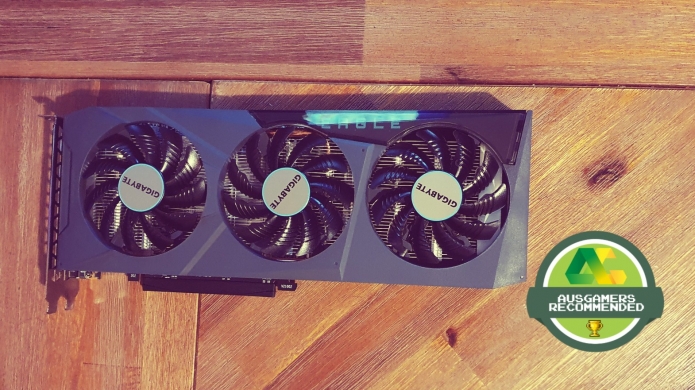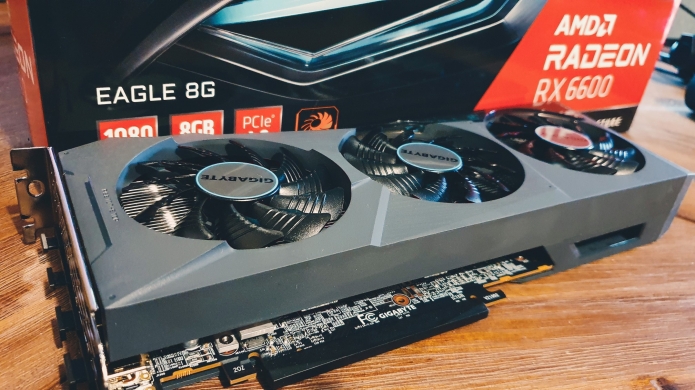Gigabyte Radeon RX 6600 Eagle 8G Review
Review By KostaAndreadis @ 12:00am 14/10/21
Product: Gigabyte AMD Radeon RX 6600 Eagle 8G
Type: Graphics Card
Price: $329 USD
Availability: October
When we reviewed AMD’s Radeon RX 6600 XT last month we noted that it was “the most mainstream and entry level option to date” in AMD’s RDNA 2 line-up. The architecture that powers the impressive 4K flagship Radeon RX 6800 XT, in addition to the Xbox Series X and PlayStation 5 consoles. Well, turns out that statement has found its expiry date -- right now. Thanks to the arrival of the new AMD Radeon RX 6600 which is effectively the new mainstream RDNA 2 offering for PC.
It drops the XT and remains the baseline Radeon RX 6600 GPU, the entry-point more or less to play the latest games. In much the same way the GeForce RTX 3060 is the baseline version of the GeForce RTX 3060 Ti and the entire Ampere range, this sits in that GPU-realm that tends to be more interesting when testing. When it comes to a mid-range or mainstream GPU, hardware makers are often looking to strike that balance between performance, efficiency, and affordability. But at the same time present something enticing enough to warrant an upgrade from something showing its age.
With the new Gigabyte AMD Radeon RX 6600 Eagle 8G (the model we’re reviewing here) we have a graphics card that AMD is touting as a 1080p powerhouse. With a whole generation of cards that have excelled at 1080p out in the wild, it kind of has to live up to that potential. Especially when firing up something new like Far Cry 6.
The AMD Radeon RX 6600 has a launch price in line with the GeForce RTX 3060’s and in any other year you could easily reserve judgement via a simple head-to-head. Performance numbers against performance numbers, temperatures, power draw, content creation stuff. The RTX 3060 we reviewed at launch was also a Gigabyte Eagle model so you’d think “well, that’s the review sorted”.
But with hardware shortages still persisting, actual GPU street prices are very far from RRP. So it’s not exactly a like-for-like when market realities mean one card could cost a lot more than another. That said, AMD has told us stock levels for the AMD Radeon RX 6600 at launch will be substantial -- more so than than the somewhat troubled GPU launches of late last year. And with that little current-climate-talk out the way let's get to the review proper.
And see just how RDNA 2 fares in pure 1080p efficiency mode.
An RDNA 2 Primer
The below is a summary of the Radeon RX 6000 Series technology, applicable to all 6600 XT models.
RDNA 2 Architecture, as per its name, is the successor to the original RDNA as seen in the Radeon RX 5700 XT. As a mid-range offering, the 5700 XT was AMD’s first 7nm powered bit of graphics tech from back in 2019. And much like its Ryzen line of CPUs, each new Radeon generation brings the same level of ‘tech maturity’ -- with the latest RDNA 2 architecture being a prime example.
With the new Gigabyte AMD Radeon RX 6600 Eagle 8G we have a graphics card that AMD is touting as a 1080p powerhouse. With a whole generation of cards that have excelled at 1080p out in the wild, it kind of has to live up to that potential.
RDNA 2 puts the Radeon name back on the map, where prior to the release of the new Radeon RX 6000 series AMD noted that RDNA 2 would provide 50% more performance-per-watt over the original RDNA. The 7nm architecture of RDNA 2, which can also be found in both the PlayStation 5 and Xbox Series X, has been created with a focus on game performance. And, it’s no surprise that’s where it shines.
What's inside the flagship Radeon RX 6800 XT can be seen as a supercharged version of what’s inside the PS5 and Xbox Series X. Not that we completely understand how a GPU works at the micro level, but much like with NVIDIA’s Ampere, RDNA 2 presents an overhaul of how each ‘Compute Unit’ works - leading to better performance and making the pretty graphics look prettier.
It doesn’t stop there as AMD has also been touting hardware-accelerated ray-tracing as a part of RDNA 2. On that front each ‘Compute Unit’ features a single Ray Accelerator that can be leveraged to handle the taxing and complex ray-tracing calculations needed for the effect.
Perhaps the most interesting innovation though comes with the introduction of AMD Infinity Cache, which is exactly how it sounds. Additional cache as seen in the CPU space to improve memory bandwidth and streaming. Of course it’s not all about hardware, and in working closely with Microsoft throughout the development of the Xbox Series X and RDNA 2 itself, DirectX 12 Ultimate features like Variable Rate Shading are fully supported in the Radeon RX 6000 series.
Plus, AMD’s answer to DLSS with its own upscaling tech called AMD FidelityFX Super Resolution (FSR) works on all GPUs and isn’t limited to RDNA 2.
Of Numbers and Heat Sinks
It might seem like a little detour but the best way to look at the specs of the new Radeon RX 6600 graphics cards is by comparing the Xbox Series X and the Xbox Series S. On one side you have a machine built for 4K, a machine that pushes visual fidelity as far as it can go in the console space. The Xbox Series S, well, that’s more of an entry-point targeting 1080p. Fast 60fps 1080p performance. Without having to worry about the absurd number of pixels in a 4K frame it’s RDNA 2 hardware is a significant step down from the Series X -- 20 Compute Units versus the Series X’s 52.
Gigabyte AMD Radeon RX 6600 Eagle 8G
- Architecture (GPU): RDNA 2
- Compute Units/Ray Accelerators: 28
- Stream Processors: 1792
- AMD Infinity Cache: 32MB
- GPU Clock: Boost: Up to 2491 MHz
- Memory Capacity: 8GB GDDR6
- Memory Interface: 128-bit
- TDP: 132W
With the Radeon RX 6600 you’re getting a similar situation, 1080p performance that sees the inclusion of 28 Compute Units versus the flagship 6800 XT’s 72. Numbers aren’t everything of course, and with this reduction you’re getting pure efficiency. The Radeon RX 6600 power-draw is rated at 132W, making it good enough for a laptop let alone desktop PC rig. Compared to the Radeon RX 6600 XT it’s a modest reduction in specs, though as we discovered in that review the result in cutting things down was a pretty sizable drop-off in performance when bumping the resolution up to 1440p.
What does this mean for the 1080p performance of the baseline Radeon RX 6600 and how it stacks up against the seemingly like-for-like GeForce RTX 3060? Or even the 6600 XT. For that we’ll have to jump into actual games to see -- which we did. So read on.
Game Performance
Okay, let’s get to it - here’s a look at the Radeon RX 6600 running the games in 1080p and 1440p with detail settings dialled up to 11 on the following setup. The following performance figures as per our testing with GPUs for review purposes were captured using out-of-the-box settings.
- GPU: Gigabyte AMD Radeon RX 6600 Eagle 8G
- CPU: AMD Ryzen 7 3800X
- Motherboard: MSI MEG X570 UNIFY
- Memory: HyperX FURY DDR4 RGB (32GB at 3600 MHz)
The first batch of games.

Comparing the Radeon RX 6600, RX 6600 XT, GeForce RTX 3060, and RTX 3060 Ti: 1080p Gaming Part One. 1080p Gaming Part Two
With this the story so far is fairly indicative of what to expect when it comes to the Radeon RX 6600, impressive 1080p performance that takes a sizable hit at 1440p. Across many titles this sits in the 30% range, with the smaller gaps presenting that thing where at 1080p there are bottlenecks outside of raw GPU power that can affect performance.
When stacked up against the RTX 3060 the 1080p performance is essentially identical. At 1440p the Radeon RX 6600 is about 5-10% slower depending on the game.
Again, we’re talking about impressive 1080p performance for a card that is power efficient and then some. Even titles that employ ray-tracing like Dirt 5 and F1 2021 run great at this resolution with detail settings cranked. Paired with the decent cooling found in the Gigabyte AMD Radeon RX 6600 Eagle 8G the in-use temperatures sit in the 60-degree range with fan-noise kept low.
Although not listed above we also managed to fit in a few benchmarks of the still-new Far Cry 6, which supports both ray-tracing and AMD’s upscaling FidelityFX Super Resolution (FSR) tech. At 1080p with ultra settings, ray-tracing, and FSR set to Ultra Quality the benchmark returned an fps average of 73.0 -- which does point to a similar sort of DLSS scenario for maintaining performance when turning on next-gen effects.

Comparing the Radeon RX 6600, RX 6600 XT, GeForce RTX 3060, and RTX 3060 Ti: 1440p Gaming Part One. 1440p Gaming Part Two
That said, the more ray-tracing intensive games out there, like Control and Cyberpunk 2077 (not listed here), did fall significantly behind the RTX 3060 range.
Across all of the testing one thing to note was that even though RDNA 2 is designed for DirectX 12 and it’s advanced features like Variable Rate Shading and Ray-Tracing, when rendering at 1440p it was the DirectX 12 titles that saw the biggest drop off in performance -- regularly dipping below 60fps. And with 60fps seen as the sort of baseline for playing PC games it does paint the picture of a card that you wouldn’t really push further than 1080p. Unless it was a competitive title like Rainbow Six Siege or something like the amazingly optimised DOOM Eternal.

This is reflected in the 3DMark results, where the Radeon RX 6600 excels when it comes to the 1080p tests but falters in others. The question of long-term viability does begin to creep into the picture, especially if you’re looking at a higher resolution display. As an RDNA 2 entry-point though, the 1080p performance is impressive. It’s hard to not be when you’re looking at 150-fps in games like Forza Horizon 4 and DOOM Eternal.
Loading Results...
Although it has copped some flack for driver stability in the past, as we’ve found throughout our testing of the Radeon RX 6000 range AMD’s Radeon Software is across the board great. From the info you get to the UI to the quick access to overclocking and other tools to monitor performance. Best of all it’s stable, even using pre-release Radeon RX 6600 beta drivers for this review we didn’t come across a single issue.
We’re talking about impressive 1080p performance for a card that is power efficient and then some. Even titles that employ ray-tracing like Dirt 5 and F1 2021 run great at this resolution with detail settings cranked.
Which brings us to the model we tested, the Gigabyte AMD Radeon RX 6600 Eagle 8G -- which as per the RTX 3060 version we tested earlier this year is also a winner. From the lightweight form-factor, to the aforementioned whisper quiet performance (basically silent) and low temps.
In the end AMD’s Radeon RX 6600 offers up decent performance, albeit in a line-up that feels overpriced taking into account the goal being 1080p performance. As a mid-range offering the 1440p drop-off is disappointing but in terms of efficiency it’s hard to argue with results.
|
What we liked
Great 1080p performance
RDNA 2 efficiency
Silent for the most part and runs cool too
|
What we didn't like
Performance drop off at 1440p is big
Limited VRAM and Infinity Cache
Not great for ray-tracing or content creation
|
We gave it:
7.5
OUT OF 10
|
Latest Comments
























Posted 01:19pm 17/10/21
Posted 01:19pm 17/10/21